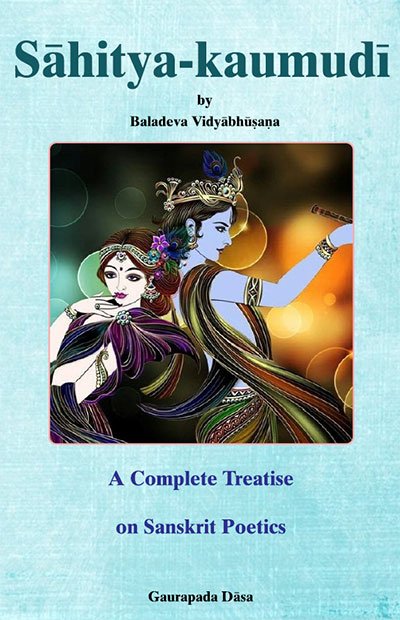Sahitya-kaumudi by Baladeva Vidyabhushana
by Gaurapada Dāsa | 2015 | 234,703 words
Baladeva Vidyabhusana’s Sahitya-kaumudi covers all aspects of poetical theory except the topic of dramaturgy. All the definitions of poetical concepts are taken from Mammata’s Kavya-prakasha, the most authoritative work on Sanskrit poetical rhetoric. Baladeva Vidyabhushana added the eleventh chapter, where he expounds additional ornaments from Visv...
Text 4.56
[This exemplifies bhāva-śābalya (conflict between vyabhicāri-bhāvas):]
पतिर् अतिकुपितो मनः प्रमत्तं खल-निकरः किल दूषणाभिधायी |
मुर-रिपुर् अपि वेश-पेशलो’सौ भण विमले कम् उपायम् आश्रयिष्ये ||
patir atikupito manaḥ pramattaṃ khala-nikaraḥ kila dūṣaṇābhidhāyī |
mura-ripur api veśa-peśalo’sau bhaṇa vimale kam upāyam āśrayiṣye ||
patiḥ—the husband; atikupitaḥ—very angry; manaḥ—the mind; pramattam—wanton; khala-nikaraḥ—the multitude of bad guys; kila—indeed; dūṣaṇa-abhidhāyī—habitually speak faults; mura-ripuḥ—Kṛṣṇa (“Mura’s enemy”); api—although; veśa-peśalaḥ—expert in the attire (or expert as regards courtezans); asau—He; bhaṇa—tell [me]; vimale—O spotless lady; kam upāyam—to what means?; āśrayiṣye—I will resort.
My husband is very angry, my mind is wanton, the mischievous people engage in faultfinding as usual, yet stylish Murāri is present. Tell me, O clear-sighted confidante, what means should I resort to?
atra bhaya-capalatā-śaṅkautsukyānāṃ mithaḥ sammarda-rūpaṃ śābalyam.
Here śābalya takes place. It is the form of a friction between bhaya (fear), capalatā (fickleness), śaṅkā (apprehension), and autsukya (eagerness).
Commentary:
Here bhaya (fear), usually classed as a sthāyi-bhāva, is a vyabhicāribhāva on the occasion. Rūpa Gosvāmī not only allows such occurrences, he says this kind of understanding is accurate. Rūpa Gosvāmī’s system of bhakti-rasa consists of two groups: One main group of five rasas (śānta, dāsya, sakhya, vātsalya, śṛṅgāra) and one secondary group of seven rasas (Mammaṭa’s nine minus śānta and śṛṅgāra). Rūpa Gosvāmī says he classes those seven as rasas only in deference to Bharata Muni because, according to Rūpa Gosvāmī, in truth those seven are vyabhicāri-bhāvas in the scope of those five.[1] The purport is that hāsya-rasa, for instance, can occur without a sthāyi-bhāva of the character in question. In such occurrences, the term sthāyi-bhāva only means vāsanā (predisposition).
This is Mammaṭa’s example of bhāva-śābalya,
kvākāryaṃ śaśa-lakṣmaṇaḥ kva ca kulaṃ bhūyo’pi dṛśyeta sā
doṣāṇāṃ praśamāya naḥ śrutam aho kope’pi kāntaṃ mukham |
kiṃ vakṣyanty apakalmaṣāḥ kṛta-dhiyaḥ svapne’pi sā durlabhā
cetaḥ svāsthyam upaihi kaḥ khalu yuvā dhanyo’dharaṃ dhāsyati ||“[Purūravā, a king in the lunar dynasty, thinks about Urvaśī:] Where on one side is the lunar dynasty, and where on the other is this improper deed? I should see her again! Our learning is meant to be a check on our bad tendencies. Gosh, her face is ravishing even when she is angry! What will the pure and wise elders say? But she is hard to get even in a dream! Calm down, O heart of mine. Alas, who is fortunate enough to kiss her lips?” (Kālidāsa’s Vikramorvaśīyam 4.34)
Mammaṭa elaborates:
atra vitarkautsukya-mati-smaraṇa-śaṅkā-dainya-dhṛti-cintānāṃ śabalatā,
“The verse features a conflict between these vyabhicārīs, sequentially: vitarka (conjecture), autsukya (eagerness), mati (thoughtfulness with regard to scriptural teachings), smaraṇa (remembrance), śaṅkā (apprehension), dainya (being miserable), dhṛti (steadfastness of the heart), and cintā (pondering)” (Kāvya-prakāśa verse 53 vṛtti).
The first sentence, which corresponds to vitarka, also constitutes the first variety of the viṣama ornament (disparity) (10.204).
